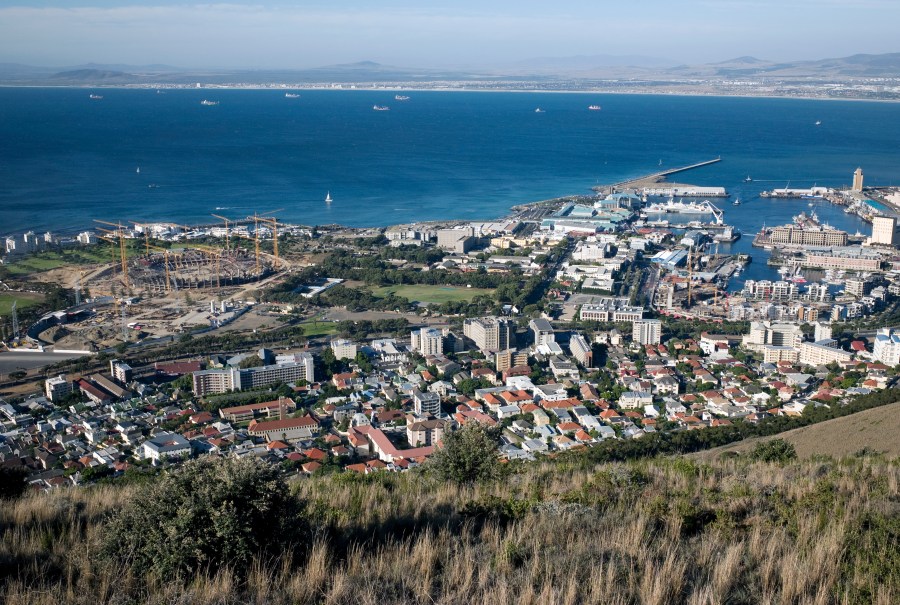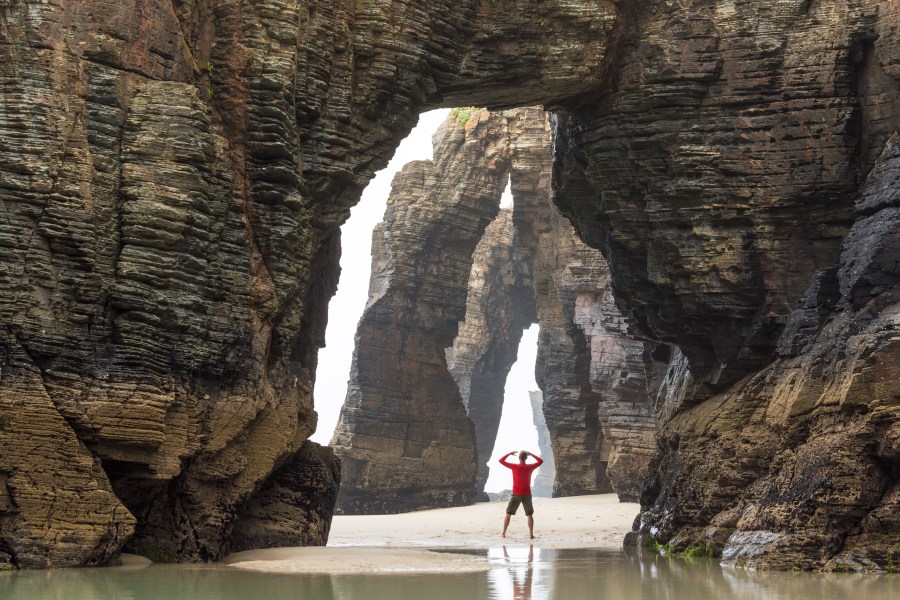What Countries Border the Atlantic Ocean?

The Atlantic Ocean, second in size only to the Pacific, encompasses an area greater than 41 million square miles. It is an ocean with rugged coastlines, beautiful tropical islands, and the world’s largest drainage area.
The Atlantic Ocean meets four different continents as well as the mythical lost continent of Atlantis, at least according to Greek philosopher Plato in his dialogues “Timaeus” and “Critias.” But for this article we’re just sticking with the continents and coastlines that exist outside of the myths. Read on to learn about the boundaries of the Atlantic Ocean.
Defining the Atlantic Ocean

The Atlantic Ocean dates back 150 million years ago to the Jurassic age after the Pangea supercontinent broke up into the continents Laurasia and Gondwanaland. When the Laurasia continent separated, it created the separation between today’s North American continent and the continents of Europe and Asia (Greenland is also a result of Laurasia’s breakup).
Consequently, the separation of the Gondwanaland supercontinent yielded the Antarctica, Australia, Africa and South America continents that we now know today. The origins of the Atlantic Ocean can be traced to the splitting of North America from the Eurasian plate.
Today, the continents of North and South America, Africa, and Europe have a border on the Atlantic Ocean. And while not classified as a continent, Central America also has countries that border the ocean as well.
The modern-day Atlantic Ocean comprises one-fifth of Earth’s surface, and it divides the European and African continents from the western hemisphere of the North and South American continents. It is also considered the youngest of the five oceans.
Origins of the Atlantic Ocean’s Name
The Atlantic Ocean’s name stems from Greek mythology in honor of the god Atlas. It means “sea of Atlas,” where Atlas was said to perform his duties. Atlas was a Titan tasked with holding up the sky in Greek lore– a castigation for warring with the Olympic Gods. In an ode to Atlas, the Atlas Mountains and water bodies off the Strait of Gibraltar are named in Atlas’s honor.
The first mention of the name Atlantic is believed to have origins in the Histories of Herodotus in 450 BC Greece.
Before the late 19th century, the southern part of the Atlantic Ocean was known as the Ethiopian Ocean. Other names associated with the south part of the Atlantic Ocean at that time were Aethiopian, sea, or ocean. The Ethiopian Ocean was also synonymous with the Ethiopian Sea and referred to the South Atlantic Ocean.
Even though Ethiopia is not on the African coast, it is one of the oldest countries in the world, and Europeans frequently used its name, “Aethiopia,” to describe various parts of Africa.
Where the Atlantic Ocean Begins and Ends

The Atlantic Ocean lies between North and South America on the western front and Europe and Africa on its eastern edge. The Norwegian Sea, the Barents Sea and the Denmark Strait connect the Atlantic Ocean with the Arctic Ocean. And up to the 1540s, the Gulf of Mexico was once considered part of the Atlantic Ocean.
The Atlantic Coast
The United States is one of the countries that border the Atlantic Ocean, and it has 14 states on the Atlantic Coast.
- Connecticut
- Delaware
- Florida
- Georgia
- Maine
- Maryland
- Massachusetts
- New Hampshire
- New Jersey
- New York
- North Carolina
- Rhode Island
- South Carolina
- Virginia
Among the 14 American States on the Atlantic Coast, also referred to as the East Coast or the Eastern Seaboard, Florida, North Carolina and Maine have the longest coastlines. Canada’s Eastern Seaboard also nestles on the Atlantic Coast. The neighboring country of Greenland is also one of the countries that border the Atlantic Ocean.
Countries with Atlantic Coastlines

While scientists predict that the Atlantic Ocean might vanish in about 220 million years, there are still 51 other Atlantic Ocean countries today.
Africa’s Atlantic Coast
In total, the African continent has 22 countries that border the Atlantic Ocean.
- Angola
- Benin
- Cameroon
- Congo
- Equatorial Guinea
- Gabon
- Guinea
- Guinea Bissau
- Ivory Coast
- Liberia
- Mauritania
- Morocco
- Nambia
- Nigeria
- Senegal
- Sierra Leone
- South Africa
- The Democratic Republic of the Congo
- The Gambia
- Togo
- Tunisia
- Western Sahara
And in the African Atlantic, tropical storms and hurricanes come off the west coast of Africa.
South America’s Atlantic Coast
South America has eight countries that border the Atlantic Ocean.
- Argentina
- Brazil
- Chile
- Columbia
- Guyana
- Suriname
- Uruguay
- Venezuela
The South American islands, the Falklands, French Guiana, South Georgia and South Sandwich islands have coastlines in the Atlantic Ocean.
Europe’s Atlantic Coast
The United Kingdom, Iceland, Belgium, and the Netherlands are some European countries that border the Atlantic Ocean. Europe’s other Atlantic Ocean countries are Portugal, Spain, western France, western Scandinavia and parts of northern Germany.
Spain’s Canary Islands and Portugal’s Azores are also located on the Atlantic Ocean.
Mexico and Central America
The Yucatán Peninsula serves as a junction between America and the Atlantic Ocean. The Gulf of Mexico joins the Atlantic Ocean by the Straits of Florida.
Central America has Belize, Honduras, Guatemala, Nicaragua and Panama have coastlines on the Atlantic. Mexico borders the Atlantic and Pacific Oceans.
The Caribbean
Puerto Rico, the Bahamas, Aruba, Grenada, Haiti, Jamaica, and Cuba are among 29 island territories and countries on the Atlantic Ocean.
Atlantic Ocean’s Main Seas

As the Atlantic Ocean continues getting wider, the configuration of its current ten seas may change in the future. But for now, the Atlantic Ocean contains the Caribbean, Mediterranean, Norwegian, Greenland, Scotia, North, Baltic and Irish seas. In addition, the English Channel and Hudson Bay are also considered Atlantic Ocean seas.
Atlantic Coastlines of Interest

Africa, South America, and European continents feature countries and island territories that are not only unique in terms of beauty and travel destinations but also geographically.
Northern Ireland’s Causeway Coastal Route
The Causeway Coastal Route spans roughly 120 miles from Belfast to Derry-Londonderry. It is a major tourist destination. The Gobbins cliff is along the Irish Sea and features a walking path carved into its rugged cliff for cave exploration.
Namibia’s Skeleton Coast
In the Caribbean, tourists book flights to scout Namibia’s 1,570-kilometer coastline. The wreckage of reportedly 500 ships littered along the coast and dunes is among the wildlife like lions, elephants and seals.
Cape Town’s Atlantic Seaboard
Along Cape Town’s jagged Atlantic Shoreline are touristic beaches like Queens Beach and Bakoven Beach. Cape Town’s Lion Head Mountain rises 2,195 ft above sea level. Lion Head also has the rare distinction of having three different rock layers.
The 12 Apostles is a mountain that is part of the Table Mountain ranges. This mountain range straddles the Atlantic coast and is full of ravines, ridges and gorges. Some of the 12 Apostles’ mountain cracks are five meters deep.
Spain’s Cathedral Beach
Also referred to in Portuguese as Catedrais, Cathedral Beach is in the Spanish province of Galicia. The natural chambers within the mountain’s edge along the Atlantic coast were formed when the Cantabrian Sea carved and carried away the softer parts of the rock. Many naturally carved-out caves and mountain arches are up to 30 meters high.





